Why Did Game Wardens Seize an Angler’s Record-Setting Crappie and Scrub it From the Record Books?
The Kansas Department of Parks and Wildlife declared the now dethroned crappie a state record back in April 2023
BY Travis Hill | PUBLISHED FEB 6, 2024

In April 2023, an angler made national headlines after the Kansas Department of Wildlife & Parks (KDWP) announced that a giant white crappie he’d caught was the biggest ever recorded in Sunflower State history. Bobby Parkhurst’s four-pound panfish broke a 60-year-old state record, according to a press release issued at the time, but it would only stay in the top spot for a few short months. In November 2023, KDWP amended their press release, striking Parkhurst’s record from the books after executing a search warrant at his home and seizing the fish from his freezer.
Parkhurst caught the crappie in dispute at Pottawatomie State Fishing Lake No. 2 near Topeka on March 5, 2023. He was fishing with a rod and reel and using a minnow for bait, KDWP said in its April press release. “As fisheries biologists, we get the chance to see a lot of big fish but this one is certainly for the books,” said KDWP assistant director of fisheries John Reinke, who recorded details about the fish’s size for the department.
The press release went on to state that Parkhurst’s crappie weighed 4.07 pounds, slightly heavier than the 4.02-pound crappie caught by Eureka’s Frank Miller in 1964. “This crappie measured in at 18-inches long and 14 inches in girth,” said Reinke. “So it truly deserves a spot on the state record list.”
Record Revoked
Parkhurst’s crappie was officially dethroned on Nov. 14, 2023 when KDWP updated its original press release with the following line: “Upon further review by KDWP officials, the crappie caught by Parkhurst could not be confirmed; therefore, the previous record for Kansas’ largest crappie still stands (Miller, 1964).”
According to reporting by KSNT.com, KDWP agents seized the frozen crappie as part of a formal investigation into paperwork that Parkhurst filed after catching the fish. “They didn’t tell me anything,” Parkhurst told the local news outlet. “I don’t understand why they’re doing this to me.”
KDWP Public Information Officer Nadia Marji told KSNT that the investigation into Parkhurst’s fish began with a tip that the agency received after announcing his record in April of last year. “There was not an error in the verification process,” Marji said. “Rather, information supplied to the Department by the angler via his written application form was not ‘true and correct.’” If the application had been filled out accurately, Marji said, Parkhurst’s crappie never would have made the books.
In a Feb. 3 Facebook post, Parkhurst publicly denied KDWP’s allegations against him. “I went through all the bells and whistles as I was supposed to do,” he wrote. “They certified and gave me the master angler award. I waited the 30 days that they by law have to wait for all this investigation to be done. These officers came to my house unlawfully and took my fish after the kdwp announced me State record holder.”
In an email, Marji told F&S that the department’s decision to revoke Parkhurst’s record came down to the crappie’s weight, which was inaccurately represented in the paperwork that he submitted to the department. Obtaining a potential record-breaking fish’s weight on a certified scale “is the responsibility of the angler,” Marji said. “They are to take their catch to the nearest certified scale—usually this is a grocery store or meat locker, and then they are to provide photographic evidence to the Department of the weigh, along with proof that the scale has recently been certified. Our staff are not equipped with certified scales.”
Marji said that fisheries “staff were not able to replicate the same weight upon re-examining the catch,” after seizing the crappie from Parkhurst’s home. An official record keeping webpage on the KDPW website confirms that Frank Miller’s 1964 state record white crappie has been restored. Like Parkhurst, Miller caught the long-standing record on a traditional rod and reel using a minnow for bait. The International Game Fish Association all-tackle world record white crappie weighed more than 5 pounds. It was caught in Mississippi in 1957 by angler Fred Bright.
Does Ozonics Actually Work? Here’s What 5 Independent, Diehard Deer Hunters Say After Field Testing
By Alex Robinson
We gave five experienced deer hunters — with no sponsors or industry affiliations — Ozonics units to field test for an entire season. Here’s what they found
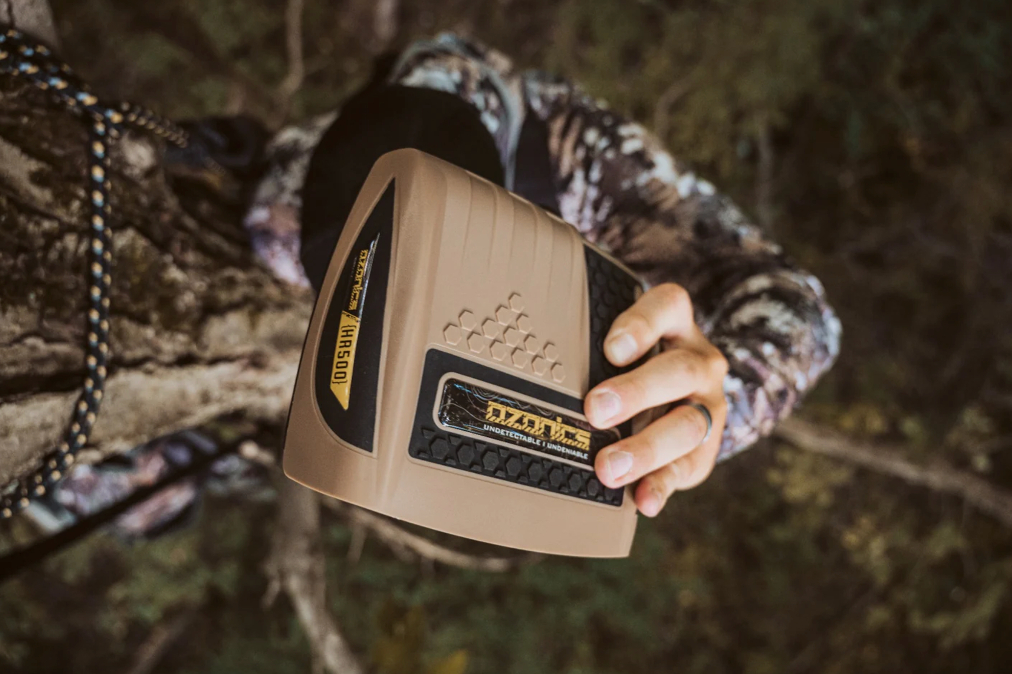
Many of the deer hunting strategies we rely on aren’t scientifically proven. For the most part, we go with the gear and tactics that have worked in the field, not necessarily in research studies. The most controversial example of this is probably scent control. Numerous products claim to minimize human scent, and some of them are gimmicks. In this world of scent-control, the most technologically-advanced strategy — as well as one of the most dubious — is to use ozone.
Ozonics is the company that first used ozone to minimize hunter’s scent in 2007. In the decades to follow, the company has sold hundreds of thousands of units, says Ozonics president Buddy Piland. The current top of the line Ozonics unit costs $456 (on sale), which is serious cash for most deer hunters. Piland admits that marketing Ozonics so it’s perceived as a legitimate product (and not a gimmick) has been a challenge over the years.
“I’m selling you an invisible molecule,” he says. “I’m saying ‘Hey, there’s something coming out of this box that will keep deer from smelling you.’”
So is the price of Ozonics worth it? Do these units actually work as advertised?
You can search around on the internet and find testimonials from a variety of deer hunting personalities promising that Ozonics is a “game changer.” But you can also find testimonials from hunting personalities and influencers promising that almost any gear item out there works, no matter how frivolous it might be.
Cynical deer hunters don’t believe the hype, and they might not even believe the anecdotes of outdoor writers and editors. As hard as we searched, we couldn’t find any scientific, peer-reviewed research on the effectiveness of using ozone to kill human scent in the field.
So we devised a totally anecdotal, but also totally unbiased, experiment of our own. We gave new Ozonics units to five diehard deer hunters who have no sponsorships, TV shows, or big social media followings, and had them test the units throughout their 2023 deer season.
They are all experienced and skilled hunters who have killed big bucks over the years, but they’re also regular dudes. Most of them work blue-collar jobs when they’re not hunting. They have no problem calling out bullshit. Most importantly, they spend a lot of time in the woods. Altogether, they had more than 400 deer encounters while running Ozonics units.
We sent each hunter a survey at the end of their season. We did not pay them for participating in the survey (and neither did Ozonics).
How Ozonics Is Supposed to Work
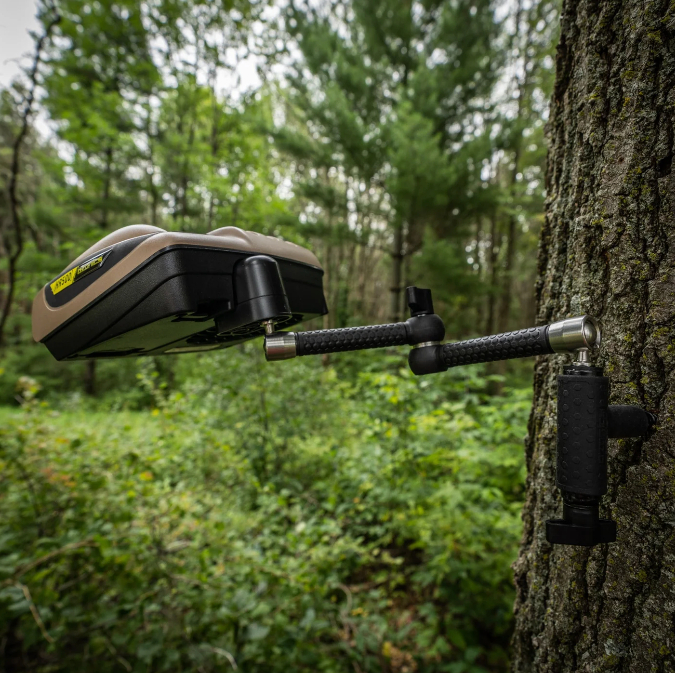
But before we can decide if Ozonics works, or doesn’t work, we need to understand ozone. As Piland puts it, ozone is a molecule made of three connected oxygen atoms (O3), which is unstable and wants to revert to its natural state. Ozone attaches to bacteria or scent molecules and oxidizes them. Ozone is used in a variety of industries but the takeaway for deer hunters is that the ozone being created by an Ozonics unit is supposed to attach to our scent molecules and neutralize them, thus preventing deer from smelling us.
There are a variety of ozone-producing devices on the market that can be used to treat clothing (usually in a bag), but Ozonics is the only company that produces a device suitable for use in the field.
Explained very plainly, an Ozonics unit creates ozone by sending high-voltage electricity through a coil and then blowing air across that coil. Over the years, the company has experimented with different levels of ozone generation and modern units now have selectable levels of ozone to match a variety of field conditions.
Piland says the best way to visualize how ozone and scent work is to imagine a stream with rocks and eddies that disrupt and change the flow of water. That’s a lot like how wind works as it moves across the landscape. Now imagine pouring red dye (your scent) into the stream. It won’t flow consistently downstream. In some places it will move faster, in others it will stop and pool. Lastly, imagine dropping purple dye (the ozone) into the stream on top of the red dye. In some places the purple will completely blanket over the red (effectively destroying your scent). In others, the red and purple will blend to make a slightly different color (altering your scent).
“[With ozone] sometimes you’ll see deer and they’ll definitely smell something, but they don’t panic and run away,” Piland says. “It’s more like, ‘Oh, I’ve never smelled that before.’”
And finally, in some places the red dye and the purple dye will never overlap. The same thing can happen with your scent in the wind. The faster the flow of the stream and the more eddies it has, the more purple dye you’ll need in order to obscure or change the red. In the field, this means more wind and more unstable wind means you need more ozone to neutralize your scent.
“So what you need to do [while hunting in higher winds] is figure out how to best dump your ozone … by adjusting the angle of the unit and the distance it is from you,” Piland says.
What the Unbiased Hunters Say
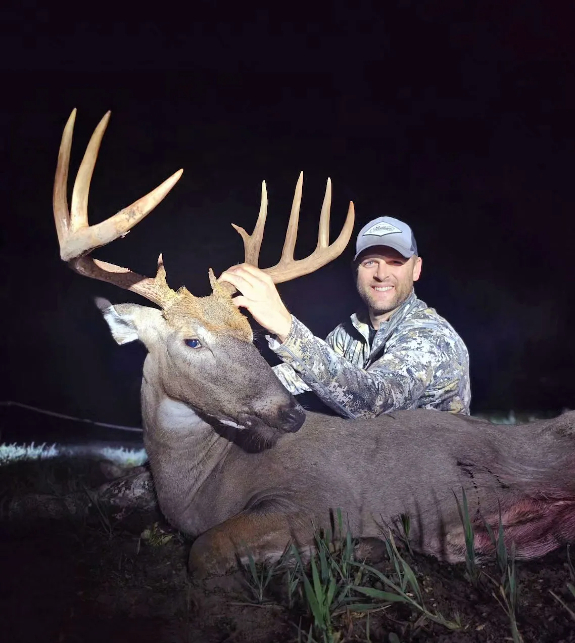
All our hunters reported that Ozonics either had a “very noticeable positive impact” on their hunt or “some noticeable positive impact” on their hunting. All of them said that they would continue to use Ozonics in the future.
Combined, they had approximately 435 deer encounters and were clearly busted by deer a total of 24 times. That’s a rate of only 5.5 percent, with many of the encounters occurring downwind. Some hunters had zero deer bust them throughout the entire season. Their anecdotes from the field provide examples of how the units performed.
Justin Cearlock, Illinois
“A good example of the Ozonics helping was an evening hunt in late October. Four doe and fawns came in upwind. A mature buck followed them in about 15 minutes later and started pushing them a little. Three of the does eventually got downwind of me. They definitely noticed a smell they didn’t like, but never were able to get enough scent to spook. They spent 10 to 15 minutes walking around with their noses in the air trying to smell me. Meanwhile the buck spent close to 10 minutes within 20 yards of me making a scrape and just watching the does. I decided not to shoot the buck, because he had a smaller rack, but there is no doubt in my mind that I don’t get that opportunity without the Ozonics.”
Brent Cearlock, Illinois
“Yes, even when trying to play the wind, deer still often manage to get downwind at times. I have noticed that with the unit on, their reaction is much less of an issue when they do get downwind. My experience has been that deer either walk right through my scent cone or if they do stop and try to wind me, they are unsure of what they are smelling and eventually continue past without snorting or blowing. The unit is not foolproof but it certainly helps, based on my experiences.”
Cole Fabro, Minnesota
“We had a questionable to flat-out-wrong wind a few times this season while sitting over food plots. Normally I would hunt something else or stay home in this situation, but I was curious about how well the system would work in this scenario. In one hunt, the deer entered the field, and they fed into my downwind side. The younger deer had zero idea that we were there. An older doe picked up enough to know that something was off, but she couldn’t seem to pinpoint our location or gather enough scent to sound the alarms. She moved about 15 yards, slightly alerted, but was calm and feeding again within a minute.
I was very skeptical before using the system. It’s impossible to completely fool a deer’s nose. However, hunting from the ground and having deer downwind of me on multiple occasions, and not having them blow out of the field in most cases was a bit mind boggling to me. The deer that would detect something seemed to be confused about what, or where, I was. And that definitely bought me more time to make a shot. I killed a nice buck in the bluffs of Minnesota where my wind was swirling fairly bad. He came to 20 yards and didn’t have a clue I was there. I’m fairly certain that scent was pushing up into the ravine at the time he came in, as I could feel the wind shift onto my neck blowing into his direction. Judging from my encounters with hundreds of deer and countless ‘scent destroying’ products, Ozonics was the only one that I believe to work as they advertise, in most cases.”
Kyle Hildreth, Minnesota
“I had many encounters with deer coming in downwind, with zero instances resulting in any deer blowing. I did, however, definitely have some encounters where I do believe the deer smelled something — whether it was the ozone or a hint of me.”
Hunter Dahl, Missouri
“I had deer walk to 10 yards downwind. They knew something was up but never busted.”
Final Thoughts on Ozonics
The hunters in our survey had a clear-eyed perspective on Ozonics. They all felt that it worked, but no one said that it was a silver bullet for fooling deer. They also agreed it was not a perfect unit — most agreed that it would be better if the unit was quieter. It didn’t spook deer, but it made it harder to hear deer approaching. It’s a bit of a hassle to set up. Plus, there are minor health concerns involved with using ozone. You should make sure to educate yourself on those issues if you’re considering springing for a unit.
But the numbers don’t lie. The hunters in our survey encountered a ton of deer and spooked very few. They all attributed at least some of that success to the Ozonics units working effectively. That might not count as scientific data, but in the mysterious world of scent control, it’s as good of a field test as you’re going to find.
The Hottest New Rifles of the 2024 SHOT Show
Check out nearly 30 new rifles from the industry's biggest gun show, from long-range tackdrivers to a new lever-action .22 from Winchester, and much more
By Richard Mann

From an affordable lever-action .22 rifle to a premium big-game rifle that’s ready for your pith helmet and a month in the African bush, there are a lot of new rifles for 2024. The two big trends that stand out in this year’s crop are familiar and ongoing ones: most of the new-for-2024 models boast features borrowed from the world of long-range competition shooting, and there are now even more options for deer hunters required to shoot straightwall cartridges. We also have a few guns celebrating manufacturing milestones this year.
But what may be the most surprising big-picture development isn’t so much about the rifles themselves as it is about the cartridges they’ll fire. It appears that the glory days of the 30-06 and 270 are now fully behind us. Once the first cartridges chambered in any new rifle, they seem to be forgotten in the 2024 lineup in favor of short-action cartridges, like the 6.5 Creedmoor and 308 Winchester, and the new big boomers, such as the 7mm and 300 PRC. In other words, it’s the end of an era—the beginning of a new one. With that said, let’s look at the latest models.
Top New Rifles for 2024
Bergara Stoke

Bergara is coming out swinging in 2024, with four interesting new hunting rifles. The least expensive is the Stoke, which is in their B-14 line. It retails for $899, weighs in at only 6 pounds, and comes with a sub-MOA accuracy guarantee. It features a chrome-moly 4140, 16.5- or 20-inch barrel that’s threaded and a compact stock that’s adjustable in ¼-inch increments for length of pull. Most models comes with a hinged floor plate, but the 223 Remington and 300 Blackout versions use a detachable 6-round AICS magazine. With its light weight and out-of-the-box 12.25-inch length of pull, it’s an ideal rifle for a young or small-stature shooter, but given its adjustable stock, it can be a good fit for anyone who wants an easy-carrying and handy rifle. Cartridge options include 223 Rem, 22-250 Rem, 300 Blackout, 243 Win, 308 Win, 6.5 Creedmoor, and 7mm-08 Rem.
Bergara Sierra

The next step up in price among the new Bergara rifles is the Sierra, which is part of the B-14 Wilderness Series. This rifle is available in 11 different chamberings from 22-250 Remington to 300 PRC, and it comes with a threaded barrel that’s either 20 or 22 inches long, depending on chambering. An omni-directional muzzle brake is standard, and the metal work is finished in Sniper grey Cerakote. The stock on the Sierra is fitted with a hinged floor plate and an adjustable comb. Nominal weight is 7.4 pounds. Like the Stoke, it comes with Bergara’s sub-MOA accuracy guarantee and retails for $1099.
Bergara Crest Carbon

The new Crest carbon is basically last year’s Squared Crest rifle upgraded with a whole lot of carbon. For 2024, you get a 20- or 22-inch CURE carbon-wrapped barrel that’s threaded and comes with an omni-directional muzzle brake. The metal work has a Sniper Grey Cerakote finish, the stock is 100 percent carbon fiber, and the rifle feeds from an AICS style detachable magazine. Available chamberings include 22-250 Rem, 6.5 Creedmoor, 6.5 PRC, 7 PRC, 308 Win, and 300 Win Mag. For all of this to exist in a 6.2 pound rifle with a sub-MOA accuracy guarantee, you can expect a commensurate price. The suggested retail is $2099.
Bergara MG MicroLite

Many manufactures are striving to offer a bolt-action rifle that’s well-configured for long-range hunting yet also light enough for deep treks into the backcountry. That’s where the Premier Series Bergara MG MicroLite rifle fits in. It can be had in 6.5 Creedmoor, 6.5 PRC, or 308 Winchester, and its magnesium chassis supports the action and a threaded, 18-inch, CURE carbon-fiber barrel. The AR-style stock folds, the comb is adjustable, the grip is near vertical, and the metal is finished in Graphite Black Cerakote. It also features a Trigger Tech trigger and feeds from a detachable AISC-style magazine. Back in 2022, we were very impressed with the Bergara’s MG MicroLite and this rifle promises to be an upgraded version of more-or-less the same thing. The MGMicro Lite comes with the company’s sub-MOA accuracy guarantee and retails for $3099.
Browning X-Bolt 2 Speed Ovix

Browning does a good job of tweaking their rifles to offer several variants of the same model, and the X-Bolt 2 Speed OVIX is a perfect example. For 2024, there are four versions, and they all have a reconfigured receiver with additional bolt guidance, but varying features and identifiers that set them apart. The first is the MB ($1499.99), and its stock has an adjustable length of pull and comb and is available in 12 chamberings, all with a Smoked Bronze Cerakote finish. The second is the SPR ($1499.99) which is a shorter-barreled version of the MB designed to better interface with suppressors. The third is the LR SR MB, which is configured for long-range shooting and has the new higher-capacity Plus magazine system. And finally, there’s the Carbon Fiber SR MB, which features a carbon-fiber-wrapped barrel and retails for $2669.99. All these rifles have threaded barrels.
Browning X Bolt 2 McMillan Stocked Rifles
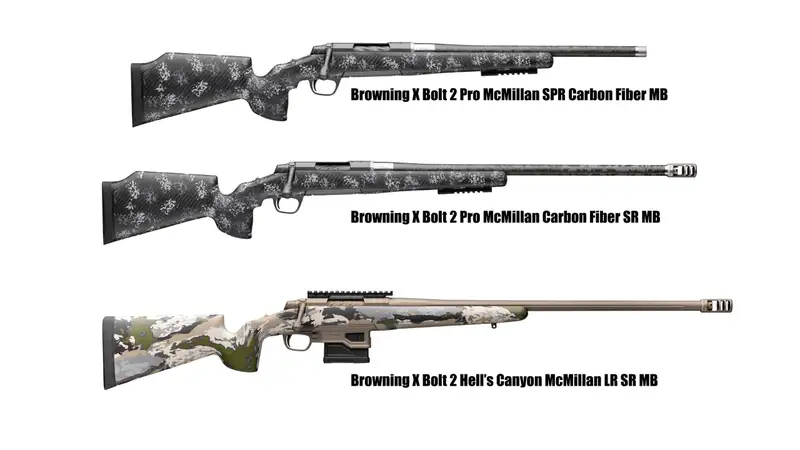
There are three new X Bolt 2 rifles from Browning that sport McMillan stocks, and like the Ovix X Bolt 2 Speed rifles, these have the reconfigured receiver with additional bolt guidance. Two come with the McMillan Game Warden 2.0 stock, which has an Urban Carbon Ambush finish and a short section of rail fitted to the underside of the forend. Both also have carbon-fiber wrapped barrels, but the SPR version has a 4-inch shorter barrel. Both are finished with in Carbon Grey Cerakote, and they’re available in 6.5 Creedmoor, 6.5 PRC, 6.8 Western, 7mm PRC, 300 PRC, 308 Winchester, and 300 Winchester Magnum, with a retail price of $3999.99. The third new Browning X Bolt 2 with a McMillan stock is the Hell’s Canyon McMillan LR SR MB. It has the Game Scout Stock finished in OVIX camo, and the metal has a Smoked Bronze Cerakote finish. The barrel is threaded and fitted with a Hawg muzzle brake and available chamberings include, 6.5 Creedmoor, 6.5 PRC, 6.8 Western, 7mm Remington Magnum, 7mm PRC, 28 Nosler, 300 Winchester Magnum, and 300 PRC. Retail price is $2599.99
CVA Cascade LRH

For most of my life, a CVA rifle was a muzzleloader, but the company recently began producing centerfire rifles, and they now offer a comprehensive collection. Their new Cascade Long Range Hunter (LRH) has a lot of features for those who like to stretch the distance—and who don’t want to spend a fortune to do it. Depending on the chambering, the Cascade LRH features either a 22-, 24-, or 26-inch, medium-contour barrel that’s threaded and comes with a radial-port muzzle brake. The synthetic stock has a quick-adjust comb and is available in two color options. A 20-MOA scope rail is standard, and the rifle has a nominal weight of 8.6 pounds. Available chamberings include the 6.5 Creedmoor, 6.5 PRC, 7mm Remington Magnum, 7mm PRC, 308 Winchester, 300 Winchester Magnum, and 300 PRC. The retail price is $900.
CVA Cascade VH

The new Cascade Varmint Hunter (VH) is very similar to the Cascade LRH. This rifle features the same adjustable stock, and either a 20- or 22-inch fluted and threaded barrel. The Cascade VH also has a detachable higher-capacity magazine, weighs in at 9.0 pounds, and comes with an MOA accuracy guarantee. It is available chambered for the 204 Ruger, 223 Remington, 22-250 Remington, or the 243 Winchester. At $900 this is a lot of rifle for a serious varmint hunter.
CVA Cascade SR 80

CVA is billing their new SR-80 rifle as a Scout Rifle designed for short-range, fast-target hunting. It has an 18-inch threaded barrel that comes with a radial brake, and it’s outfitted with a rear aperture and front post sight. A 70-degree bolt throw, a synthetic stock with an adjustable length of pull, and detachable magazine are standard, and the rifle is available chambered for either 308 Winchester or 350 Legend. I assume the open sights, combined with the forward-mounted Picatinny rail for mounting an extended-eye-relief scope or a red dot, is why CVA decided the SR-80 could be a Scout Rifle, but at 7.3 pounds it’s a bit heavy to effectively assume that title. But, of course, what you call it won’t change how well it shoots or how much fun you’ll have with it. The SR-80 has a suggested retail price of $925.00.
Diamondback DB15 350 Legend

Mostly known for their ultra-compact pistols, Diamondback also builds modern sporting rifles in a variety of configurations. In the last few years, the straightwall 350 Legend cartridge has really caught on, and to meet the demand, Diamondback has introduced the DB15 in 350 Legend. It has a 16-inch medium-contour 4150 chrome moly threaded barrel with a 1 in 8 twist that’s fitted to an A3 style flattop upper receiver forged from 7075 T-6 aluminum. It also has a 15-inch M-Lok rail that has anti-slip textured pads, and the lower receiver is also machined from 7075 T-6 aluminum. The rifle has a black hard-coat anodized finish and a Mag Pull CTR stock and MOE K2 grip. It ships with one 5-round and one 10-round magazine, and only weighs 6.6 pounds. Suggested retail is $1111.
John Rigby & Company Big Game Lightweight Rifle

John Rigby & Company was founded in Dublin in 1775 and is still going strong almost 250 years later. Their latest rifle is the Big Game Lightweight, and it puts you in mind of a pre-war safari expedition rifle. It’s built on a Mauser M98 Magnum square-bridge action that has a three-position side safety and 5+1 capacity. The 24-inch barrel is as slim as a gemsbok horn, and the Grade 5 walnut stock is a beautiful as a bongo’s hide. Open sights are standard, and the rifle is chambered for the classic 350 Rigby Magnum cartridge, which is suitable for big-game hunting anywhere in the world. At 9.25 pounds, I’d not consider it a lightweight, but it weighs a full pound less than Rigby’s standard Big Gamer Rifle. How much does it cost? Are you sitting down? The suggested retail is £10,950 pounds, which translates to only $13,978.72 American dollars.
Mossberg Patriot 400 Legend
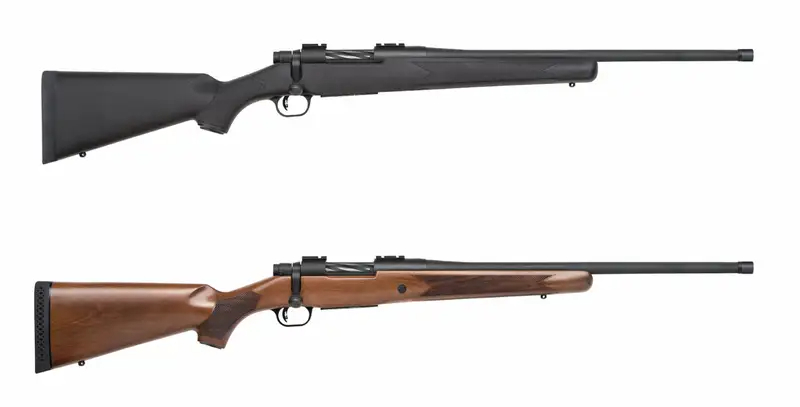
In 2014, I took the first Mossberg Patriot rifle on safari in Africa. Since then, I’ve used Mossberg Patriots to hunt all over the world. A combination of affordability, reliability, and performance has made the Patriot line of rifles very popular with hunters, and for 2024, Mossberg has added the straightwall 400 Legend chambering to the family. Two rifles will be offered, and both will have a threaded 20-inch barrel, a four-round flush-fitting detachable box magazine, and Mossberg’s Lightning Bolt Action (LBA) trigger system. With an overall length of 40.25 inches, the walnut-stocked Patriot in 400 Legend will weigh 7.0 pounds, and the synthetic-stocked version weighs a half-pound less. Suggested retail will be $669 and $484, respectively.
Ruger Anniversary 10/22s

Sixty years ago, the world of rimfire rifles changed when Ruger introduced the 10/22. This affordable and reliable semi-automatic rimfire rifle would go on to raise countless hunters, train millions of shooters, and become one of the most iconic rimfires ever. To celebrate this six-decade anniversary, Ruger has introduced their 10/22 60th Anniversary Model, which features a grey Magpul Hunter X22 stock with an adjustable length of pull and comb height, multiple sling attachment points, and M-Lok slots along the forend. It also features a Picatinny rail with an integral and adjustable aperture sight; a red charging handle and trigger; and a threaded muzzle with a flash suppressor already installed. Suggested retail is $639. To celebrate their 75th anniversary of making guns, Ruger is also offering two other 10/22s. Both are stainless with an 18.5-inch barrel, featuring either a walnut or natural finished hardwood stock. These go for $399.
Smith & Wesson Model 1854
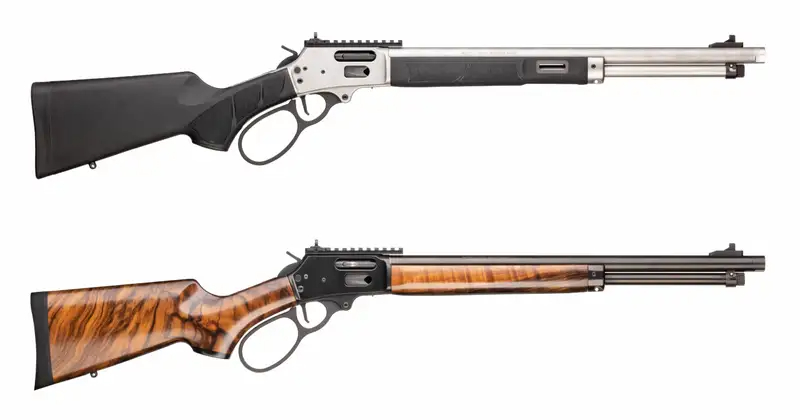
If you think the lever-action rifle is a thing of the past, you’re wrong. In a move that will surprise everyone, Smith & Wesson has introduced a new lever-action rifle for 2024. The Model 1854 from Smith & Wesson harkens back 170 years ago to when S&W patented their first lever-action rifle, the Volcanic. Two versions of this rifle will be offered, and both will be built on a stainless-steel receiver and are chambered for the 44 Remington Magnum. Both will also have a 19.25-inch threaded barrel, a 9+1 capacity, a large loop lever, an optics rail, and an XS ghost ring rear sight and gold bead front sight. Both have a magazine tube that can be loaded or unloaded from the front, and they’ll weigh in at about 7 pounds. The standard version will have a satin stainless finish and will be fitted with a synthetic stock that has M-Lok compatibility. The Limited Edition version will have a black PVD finish and a high grade walnut stock. Price is not yet available.
Stag Arms Pursuit Carbon

In 2023, Stag Arms introduced their first bolt-action rifle, which showcased a modern modular approach. For 2024, they’ve basically started with that rifle and added a threaded, 416R stainless-steel, carbon-fiber-jacketed barrel that should cut weight a bit. This is a chassis-style rifle built around a three-lug bolt with a 60-degree throw that has dual ejectors and can be disassembled without tools. The rigid, synthetic butt stock is adjustable for length of pull, has an adjustable comb, and can be removed from the chassis with a single AR-style pin. There’s multiple QD sling-swivel attachment points, a Picatinny spigot, and there’s M-Lok compatibility underneath the forend. The rifle comes standard with a Trigger Tech trigger, feeds from AISC magazines, and the metal parts have a black Cerakote finish. Stock color options are black, tan, and green. The new Pursuit Carbon will sell for $2399.
Stag Arms Stag 10 and Stag 15 Pursuit Carbon

Last year Stag Arms also introduced two modern sporting rifles configured for hunting, and we reviewed one in our recent rifle test. This year, Stag has added a BSF carbon-fiber barrel option to these rifles. The Stag 10 Pursuit Carbon is available in 308 Winchester with a 16-inch barrel and in 6.5 Creedmoor with an 18-inch barrel. The Stag 15 Carbon Pursuit is available in 223 Remington, with a 223 Wylde chamber for 5.56 NATO compatibility, 6mm ARC, and even for the new 22 ARC cartridge. All three will have an 18-inch barrel. Also, all Stag AR-style Pursuit rifles have a Midnight Bronze Cerakote finish and the distinctive leather pad on the comb of the adjustable stock. The new carbon-barrel Pursuit rifles also have an upgraded trigger and a custom leather wrap on the handguard. The Stag 15 sells for $1899, and the Stag 10 for $2499.
Weatherby Model 307 Range XP

This Weatherby rifle was launched at last year’s SHOT Show, but it’s only now starting to ship, so we are including it here in case you forgot about it. It’s built on Weatherby’s new 307 action, which has a Remington 700 footprint, and it’s Weatherby’s first new rifle action since 1971. This is a synthetic-stocked rifle with an adjustable comb, available in 12 chamberings, including nine standard and three Weatherby cartridges. It has a spiral-fluted threaded barrel, feeds from a detachable AICS magazines, and barrel length varies from 24 to 28 inches depending on the cartridge. The best thing about this rifle is that it’s a Weatherby and it only costs $1199.
Winchester Ranger

Of all the lever-action rifles that have or ever will exist, Winchester’s are the most iconic. And while all lever guns are fun to shoot, the most fun is one chambered for the 22 LR. It’s been a long time since you could buy a brand new Winchester lever-action 22. There are some used ones out there, but if you don’t have a grand in your pocket, don’t bother. And now you don’t have to, because for 2024, Winchester has introduced the Ranger, a traditionally styled lever-action rifle chambered for the 22 LR that retails for only $419. The rifle has a walnut stock and forearm, a hard-anodized aluminum receiver, and brakes down into two equal halves.
Bonus Gear: Aero Precision’s New Actions
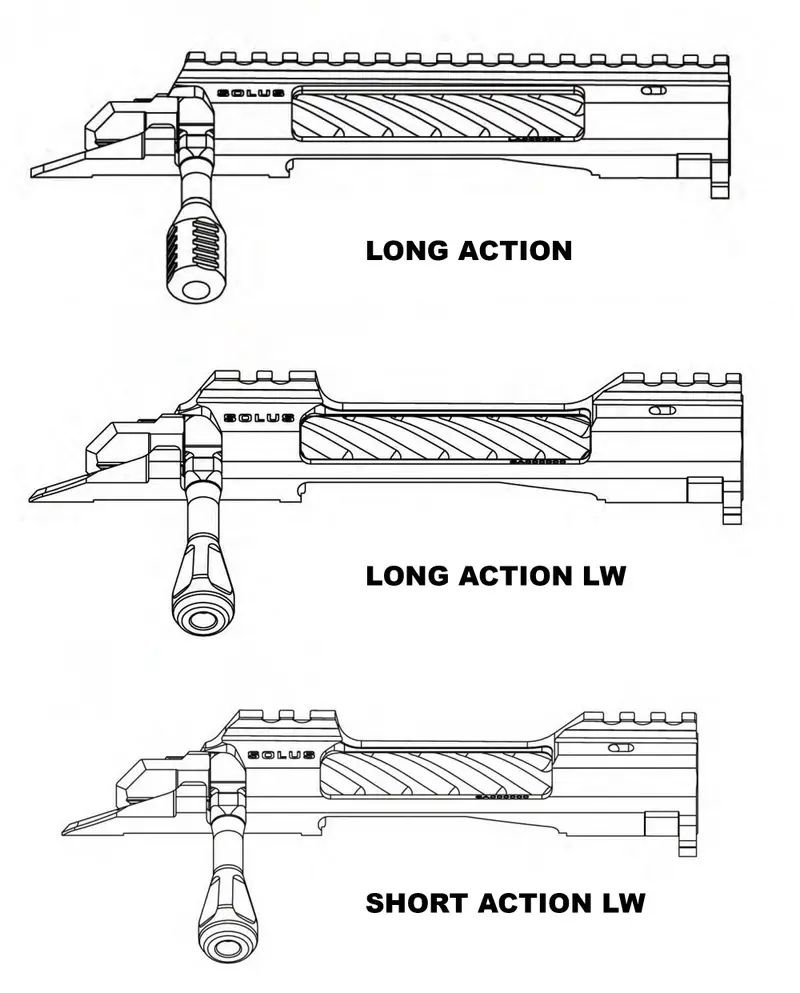
Though not complete rifles, these new actions from Aero Precision are included because I was so impressed with their SOLUS rifle I recently tested, but also because of their Remington 700 footprint, which is compatible with hordes of aftermarket rifle stocks, triggers, AICS magazines, and Savage small shank barrels. The first is a standard long action with a full-length 20-MOA top rail that retails for $974. The other two are lightweight versions of their long and short actions. Both have an interrupted, integral 20-MOA top rail and a fluted bolt body, and they retail for $949. All SOLUS actions have a three-lug toolless, quick disassemble bolt with a 60-degree throw, and the bolt head is interchangeable between a 0.478 and 0.540 diameter face.
How to Ice Fish for Giant Walleye, Lake Trout, and Perch
Three ice fishing experts share their go-to tactics for catching hard-water trophies
By Andrew Pegman
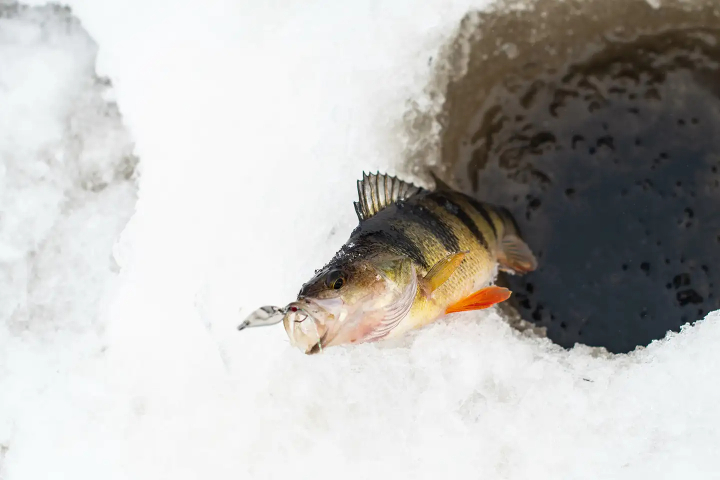
As temperatures continue to drop everywhere, fishermen are gearing up to head out onto the ice. But for beginners, ice fishing can be a daunting pursuit. Since you don’t have the freedom and flexibility to motor from spot to spot, how do you know where to start on the ice? We asked three expert ice fishing anglers for their best tips for success. Combined, they have decades of hard-water experience behind them, and they can help you figure out not only where to fish and what tactics to use—but how to catch some of the biggest fish of your life.
Ice Fishing Expert: Brian “Bro” Brosdahl
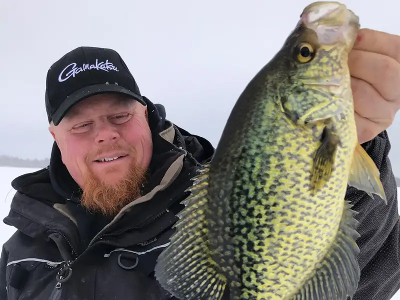
Minnesota-based guide Brian Brosdahl—known simply as “Bro” in many fishing circles—is a multi-species expert. Here, he shares his best tips and techniques on how to fish for slab crappies, monster pike, and beefy walleyes.
Crappie: “For numbers, I really love to ice fish shallow, healthy lakes on the weed edges and in the vegetation,” Brosdahl says. “But the big slabs often lurk deep in the basins, wherever there is forage.
“For large crappies, I’ll use a small spoon, like a Buck Shot Rattle Spoon in dark, stained water,” he continues. “Remember that in some lakes, it’s a finesse bite. I also like to fish jigs like the Mooska or a Mud Bug with a little tail or tipped with a minnow head or a wax worm.” He likes to use a wiggle on the retrieve to mimic the motion of a baitfish. “Keep it above the fish. Don’t set the hook in the middle of the school. Pluck the star off the Christmas tree. That way, their friends won’t know.”
Brosdahl uses 2- to 3-pound line for crappies. “In vegetation, you can go thicker, but open water will make heavier line stand out more,” he says. “Don’t use split shot or sinkers. These are big creatures, but their mouths are fragile. Just pluck them with a slight uptick when you set the hook. Be patient. You might just see a twitch. It’s a very subtle bite.”
Walleye: Brosdahl targets trophy walleyes in the late fall. Scout out areas of good walleye habitat like structure with weeds or rocks on top. Whitefish tend to spawn in these areas, and the walleye come in to chase the whitefish. “Chasing big ones is fun because they are as heavy as they’re going to get,” he says. “These early feeders are fat, and larger baits are the key.” A big sucker minnow rigged on a 2.5-inch Buck Shot Rattle Spoon is a real walleye treat, he says.
Brosdahl adds that you don’t have to use a giant bait to catch walleye. You can also fish what he calls a Bloody Stump. Take a minnow and snip it just past the air sack so that it’s still alive. Hook the minnow through the top of the nose and have it exit through the bottom of the jaw. “The carnage appeals to a walleye’s predatory instincts,” Brosdahl says. “When fish are aggressive, I’ll use a whole lively minnow and jig the whole works.”
“Another good technique is pounding the bottom of the basin and pulling up fast,” he says. This strategy can get the big walleye cruising the bottom and trigger their instinct bite. “They have their instinctive lanes, but sometimes in deeper water, they’ll suspend and feed up. Remember that walleyes can’t always see it, but they can feel it. Start jigging at about 6 to 8 feet deep for suspended walleyes and work it down. I like to drop it down and stir up the bottom because walleyes eat crayfish and frogs, too.”
Northern Pike: “I like catching large pike—not the nuisance pike,” Brosdahl says. “For big pike, I fish large lakes that have plenty of forage. Pike are fun because it’s a different kind of fishing. I like to set lines because pike are usually not as active. Try using sucker minnows, or dead baits that are oily and stinky on a Northland Predator Rig. Big pike love oily, stinky baits.”
Another technique Brosdahl uses is jigging a lively sucker minnow or jigging a big, fluttery spoon. He likes using colors like red and orange to imitate perch and bluegills. Something with a silvery or golden flash works, too.
Brosdahl says the pike bite is definitely a waiting game “We’ve set up a portable couch and chairs and a fire pit. It’s hard to be patient when you want them to bite now, but landing that trophy often requires patience.”
Ice Fishing Expert: Tim Moore
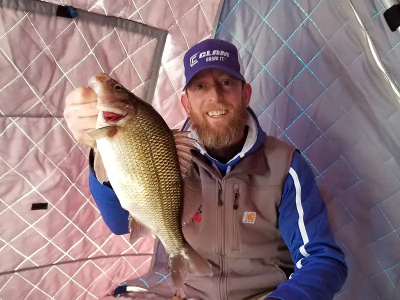
Tim Moore got hooked on ice fishing by chasing smelt with his dad among the shanties dotting the Great Bay coves. For the past 14 years, he’s been guiding professionally on Lake Winnipesauke, in New Hampshire, and focusing on trophy white perch.
White Perch: Moore says that Lake Winnipesauke boasts some of the largest white perch in the country. “The average white perch in Winnipesauke is 12 to 14 inches, and many get up to two or three pounds,” he says. “We call those jumbos.”
Moore fishes with a 28-inch spinning rod and 4-pound line. He uses heavier test because he likes to get the fish up quickly. He says white clam-blade jigs work well in the clear water of Winnipesauke. “We use a single hook point tipped with a worm to get them going,” he explains. “If they’re finicky, we may tip with a maggot instead. After that, it’s run and gun.”
The strategy for jumbos is to hunt the basins. “White perch fishing translates well to striper fishing,” Moore says. “They school up by size, they are nomadic, and they migrate to spawn. White perch work a school of bait, and some days you can go from nothing to 15 feet of fish below you in a matter of moments. The biggest fish tend to stay on the bottom or the outside of the school. Try to get on the bottom and retrieve with a slow, short cadence—use a tap, tap approach. Once one comes away, more will follow. Get that first one to bite, and it’s game on.”
Ice Fishing Expert: Mike Howe
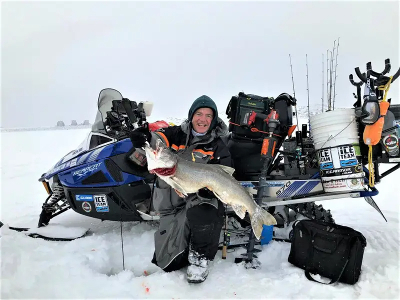
Howe is a Montana guide and outfitter who grew up loving anything that has to do with the outdoors. “Something about ice fishing checks all the boxes for me,” Howe said. “And if I had to choose one outdoor pursuit, my true passion is chasing monster lake trout.”
Lake Trout: “Lake trout are large, aggressive predators,” Howe says. “Number one, you have to have good electronics. I like to use a simple Vexilar flasher in really gnarly conditions.” Howe fishes for big lake trout in 60 to 200 feet of water. “A camera has limitations. It’s important to understand maps and what the fish want. Look for major structure, cliffs, and drop-offs. We’re fishing huge bodies of water.
“Lake trout spend time on the move looking for forage,” he continues. “They’re hunters. They’ll camp on a school of fish, but they’re constantly on the move.” In terms of forage, lake trout eat cicso, whitefish, and yellow perch. The essential baits Howe likes to have in his arsenal are heavy, flashy spoons like the Super Leech Spoon from Clam Outdoors. “I start with a heavy flutter spoon, with lots of weight, thump, vibration, and flash. I don’t tip it. I use it to gauge the movement and aggression of the trout.”
Howe likes to hunt and catch the most aggressive fish in the pack first. “If I can take the biggest fish, the rest will fall in. If you’re fishing as a team, while you’re fighting the monster, start popping holes and drop down. Your buddy will get the second biggest.”
If spoons aren’t working, Howe likes tube jigs, particularly those with a few gashes and battle scars and scent in the body. “The more torn up the tube, the better it performs,” he says. “Lakers tend to stun a baitfish. One or two lakers will shred through a school of baitfish. They will stun or injure them, and the biggest ones will pick off the injured.”
Howe fishes with light tackle, even though 20-pound plus lakers are common. “You need something medium to medium-heavy—30- to 40-inch rods with some forgiveness,” he says. “Braided line is a must with a fluorocarbon leader, especially while you’re banging jigs.”
Keep a tight line on lake trout because they can turn and move so fast. “That’s the beauty of lake trout fishing,” Howe says. “That fish is in control, and you’re along for the ride.”
Sunfish vs Bluegill: There’s Really No Debate
Bluegills are the MVP of the sunfish family due to their easy access, aggressive nature, and delicious table fare
By David A. Brown
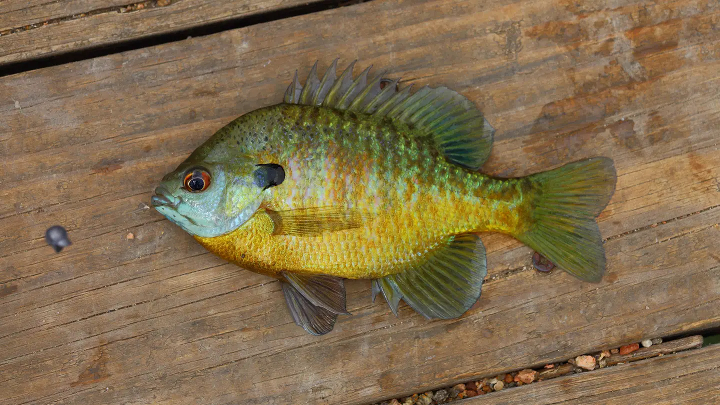
If you’re wondering about sunfish vs bluegill, there’s something we should probably get straightened out right off the bat. Run a background check on bluegill, and you’ll see they’re actually a member of the sunfish family—a diverse clan widely distributed through North America’s fresh waters. This group includes well-known and commonly targeted species like redear, red breast, green, spotted, and longer sunfish, along with fliers and pumpkinseeds. However, most anglers consider bluegill the sunfish MVP.
Biologists know them as Lepomis macrochirus, while regional nicknames include bream, sunny, and inaccurately, perch. By any moniker, the bluegill enjoys top-shelf status among its sunfish kin. So, in case you get into a heated debate at fish camp about sunfish vs bluegill, here is everything you need to know to debunk your fishing buddies.
Appearance and Identification
A boldly photogenic fish, the bluegill takes its name from the blue tones accenting the lower portion of its jaw and gill covers. The deep, flattened body draws to a blunt head, with a relatively small mouth slanting downward, but not reaching as far back as the eyes.
Bluegill have a short, broad ear flap that’s dark blue/black, while their typically greenish-brown sides hold several dark, vertical bands. During the breeding season, males become bluish-green with darker bars and bright blue tones on the head and rusty orange chests. In any season, females are usually lighter in color.
We aren’t putting down the other sunfish, as many boast catch-worthy size and aggression. But there’s a reason Texas A&M’s AgriLife Extension touts the bluegill as the most common forage fish stocked in southern farm ponds. Growth rates, spawning success, and bass appeal certainly matter here, but for anglers, the bluegill brings a lot more to the table.
For clarity, the sunfish family also includes the black bass gang, along with the ‘tweener species, like black and white crappie. To keep it apples-to-apples, we’ll focus on why bluegill tops the family’s more numerous branches, casually known as panfish.
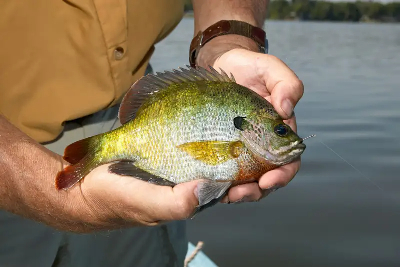
Availability & Access
Native to much of the eastern and central U.S., stocking and other introductions have enabled bluegill to find their way across the country and into Hawaii and Puerto Rico. The U.S. Geological Survey states the bluegill’s native range as the St. Lawrence-Great Lakes and Mississippi River basins from Quebec and New York to Minnesota and south to the Gulf, as well as the Atlantic and Gulf Slope drainages from the Cape Fear River, Virginia, to the Rio Grande, Texas, New Mexico, and northern Mexico.
It is important to note Florida also has a native subspecies known as the coppernose bluegill (L. macrochirus purpurascens) that’s commonly raised and sold for southeastern pond stocking. During the breeding season, a male coppernose displays a purplish head and a copper-colored band across the head above the eyes.
“I think bluegill is the (sunfish) species that people fish for the most due to its widespread range,” said Allen Martin, Regional Fisheries Administrator for the Florida Fish and Wildlife Conservation Commission. “You can catch them just about everywhere.”
As Martin notes, the green sunfish (aka goggle-eye, rock bass, or branch perch), while not present in Florida, also boasts a nationwide distribution, second only to the bluegill. The two often occur adjacently, but in terms of angler access, the green sunfish tends to spend more time deeper, while the bluegill may feed from inches of shoreline water out to deep weed beds in 12 feet or more.
As for water bodies, the bluegill shows tremendous diversity by thriving in everything from large natural lakes to reservoirs, rivers, and even retention ponds. Storm drains and seasonal overflows always seem to boost the bluegill’s expansion. Ideal for land-based anglers—especially kids and beginners—bluegill often show themselves around shallow vegetation, docks, sea walls, and open water along lightly trafficked shorelines.
Tips and Tactics
Schools of 5 to 10 bluegill are common, while larger aggregations can occur, especially during prime feeding scenarios. Sight-feeding omnivores, these premier panfish consume aquatic vegetation, zooplankton, insect larvae, insects, invertebrates, fish eggs, minnows, and other small fish.
“It’s pretty simple fishing and one of the first fish you take a kid to catch”, said Martin. “From an angling standpoint, they bite pretty regularly and eat a wide variety of baits.”
When it comes to targeting these gluttons, anglers equipped with small hooks, split shots, bobbers, and their choice of crickets, earthworms, or bread balls will fare well. While those seeking higher sport may use small jigs under slip floats, tiny crankbaits, jerk baits, and flies (insect patterns and poppers). Through the ice, a tiny tungsten jig tipped with maggots is the ticket.
Want to find out if your area holds bluegill? Chum the water with pieces of sliced bread. The turtles and ducks will eventually grab their share, but bluegills are not bashful, so look for the swirls and pops to judge quality and quantity.
“Bluegill will fight super hard for their size, often spinning in circles and wrapping an angler’s line on vegetation or brush,” said Minnesota guide Brian “Bro” Brosdahl. “That makes them a formidable battle on light line.”
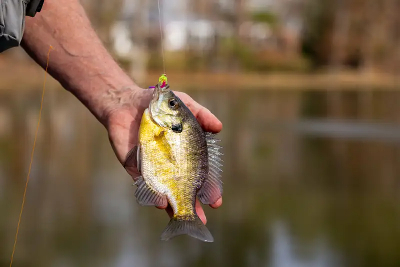
A Worthy Target
While loads of smaller bluegill provide nearly non-stop fun for kids with cane poles or spincast tackle, serious anglers willing to put in the effort can find hefty “eater” size ‘gills in open water and through the ice. The U.S. Fish & Wildlife Service says 7 1/2 inches is a common size, but ‘gills in prime growing scenarios may reach 16 inches. The IGFA all-tackle world record was a 4-pound, 12-ounce whopper caught on April 9, 1950, on Alabama’s Ketona Lake.
In terms of size potential, redear sunfish (aka Shellcracker) may exhibit regionally superior growth. Arizona’s Lake Havasu comes to mind, with the IGFA all-tackle world record standing at 6 pounds, 4 ounces (caught May 4, 2021). On average, though, bluegill can hold their own against redear.
Here’s a quick way to distinguish the two species: the redear’s dark ear flap includes a red border, and the sides have more of a golden, often speckled, coloration with vertical banding much fainter than that of a bluegill.
Table Fare
Bluegills offer delicate white meat second only to the crappie in the panfish options. For optimal quality, keep your catch fresh on ice until cleaning time. Brosdahl urges anglers to release the larger bluegill for spawning and nest-guarding duties. A limit of medium-sized ‘gills can make for a dandy fish fry. Some filet their bluegill, but old-schoolers scale and gut their fish, then coat in corn meal and fry until golden brown. Hold the tail and pick the flaky white meat right off the bones. Hot sauce is optional, but hush puppies are mandatory.

